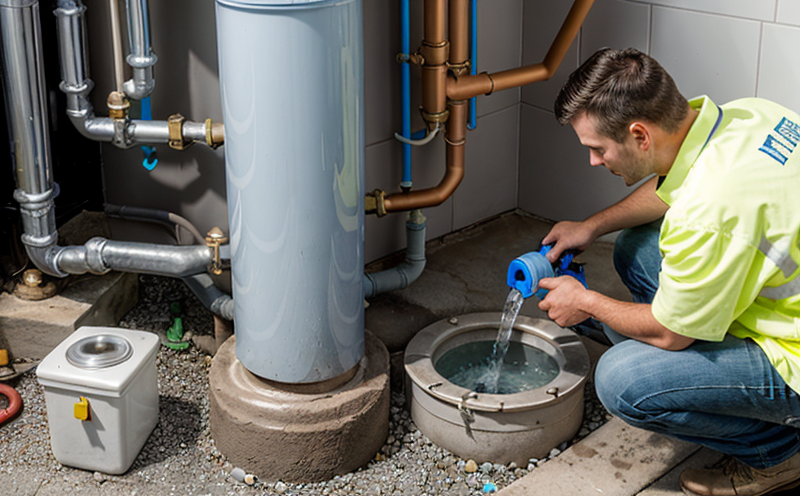ISO 5667-6 Water Sampling Documentation
The ISO 5667-6 standard is a crucial document for water sampling in plumbing and water systems. It ensures that samples are collected, handled, and documented accurately to meet regulatory requirements and ensure the integrity of subsequent tests. The standard aims to minimize contamination during sample collection and handling, which can compromise the accuracy and reliability of analytical results.
ISO 5667-6 provides detailed guidance on the selection of sampling locations, the use of appropriate containers for different types of water samples, and the correct procedures for storing and transporting samples. It also specifies how to document the sample information in a way that can be easily understood by all stakeholders involved in the testing process.
Understanding the importance of accurate water sampling is critical for quality managers, compliance officers, R&D engineers, and procurement professionals working in the building and infrastructure sector. By adhering to ISO 5667-6, these individuals can ensure that samples are collected correctly, reducing the risk of errors or contamination that could invalidate test results.
The standard covers a wide range of water sampling scenarios relevant to plumbing systems, including potable water supplies, fire protection systems, and irrigation systems. It provides specific recommendations for the type of container to use (e.g., polyethylene bottles) and the volume of sample required, depending on the intended analysis.
Proper documentation is a key aspect of ISO 5667-6 compliance. This includes recording information such as the date and time of sampling, environmental conditions at the time of collection, the identity of the collector, and any deviations from standard procedures. This documentation ensures that samples can be traced back to their origin, supporting quality assurance efforts.
One of the primary benefits of adhering to ISO 5667-6 is enhanced trust in test results among stakeholders. When samples are collected according to this standard, there is greater confidence that the results reflect true water quality conditions. This is particularly important for compliance officers tasked with ensuring regulatory adherence and for R&D engineers looking to develop new products or processes based on accurate data.
Quality managers can also benefit from ISO 5667-6 by ensuring consistent sample collection practices across their organization, which helps maintain high standards of quality assurance. Proper sampling techniques are crucial in the procurement process as well, helping to ensure that suppliers meet stringent quality and safety criteria.
The standard's emphasis on minimizing contamination during sampling is especially important for testing potable water supplies. Any contamination can lead to inaccurate results, which could have serious implications for public health and safety. By following ISO 5667-6, plumbing professionals can help ensure that samples are collected in a way that preserves the integrity of the water being tested.
In summary, ISO 5667-6 plays a vital role in ensuring accurate and reliable water sampling for plumbing systems. Its detailed guidelines on sample collection, handling, and documentation provide a robust framework for quality managers, compliance officers, R&D engineers, and procurement professionals to follow. Adhering to this standard not only enhances the credibility of test results but also contributes to better decision-making processes within organizations.
Applied Standards
- ISO 5667-6:2019 – specifies the requirements for water sampling and documentation in plumbing systems.
- ASTM D3484-18a – provides a standard test method for determining the pH of water using potentiometric techniques, which is often used alongside ISO 5667-6.
- EN 12859 – sets out guidelines for the design and construction of drinking water systems, including sampling points required by ISO 5667-6.
The application of these standards is essential to ensure that water samples are collected in a manner consistent with international best practices. Compliance with such standards helps maintain high levels of quality and safety in plumbing systems across various sectors, including residential buildings, commercial structures, and public facilities.
Industry Applications
- Residential Buildings: Ensuring that water samples from potable supplies are collected accurately for compliance with local regulations.
- Commercial Structures: Verifying the integrity of fire protection systems through proper sampling and documentation.
- Public Facilities: Guaranteeing the safety and quality of irrigation systems to protect public health.
- New Construction Projects: Implementing ISO 5667-6 early in the design phase ensures that all sampling points meet the required standards.
In each of these applications, accurate water sampling is crucial for maintaining compliance with relevant regulations and ensuring the safety and quality of water systems. By adhering to ISO 5667-6, organizations can demonstrate their commitment to high standards of quality assurance and safety.
Environmental and Sustainability Contributions
The implementation of ISO 5667-6 contributes significantly to environmental sustainability by ensuring that water samples are collected accurately, minimizing the risk of contamination. This accuracy is vital for effective monitoring and management of water resources, which are critical components of sustainable development.
By following this standard, organizations can also reduce waste associated with incorrect sample collection. Properly documented sampling ensures that only necessary samples are taken, helping to conserve resources and minimize environmental impact. Moreover, accurate data from ISO 5667-6 compliant sampling supports informed decision-making regarding water usage, conservation efforts, and infrastructure improvements.
The standard’s focus on minimizing contamination also plays a role in protecting ecosystems and biodiversity by ensuring that water quality is accurately assessed. This contributes to broader environmental goals such as reducing pollution and promoting sustainable use of natural resources.
In conclusion, ISO 5667-6 supports sustainability efforts within the building and infrastructure sector by fostering accurate and reliable data collection, which can be used to inform better decision-making processes aimed at enhancing environmental protection and resource management.





